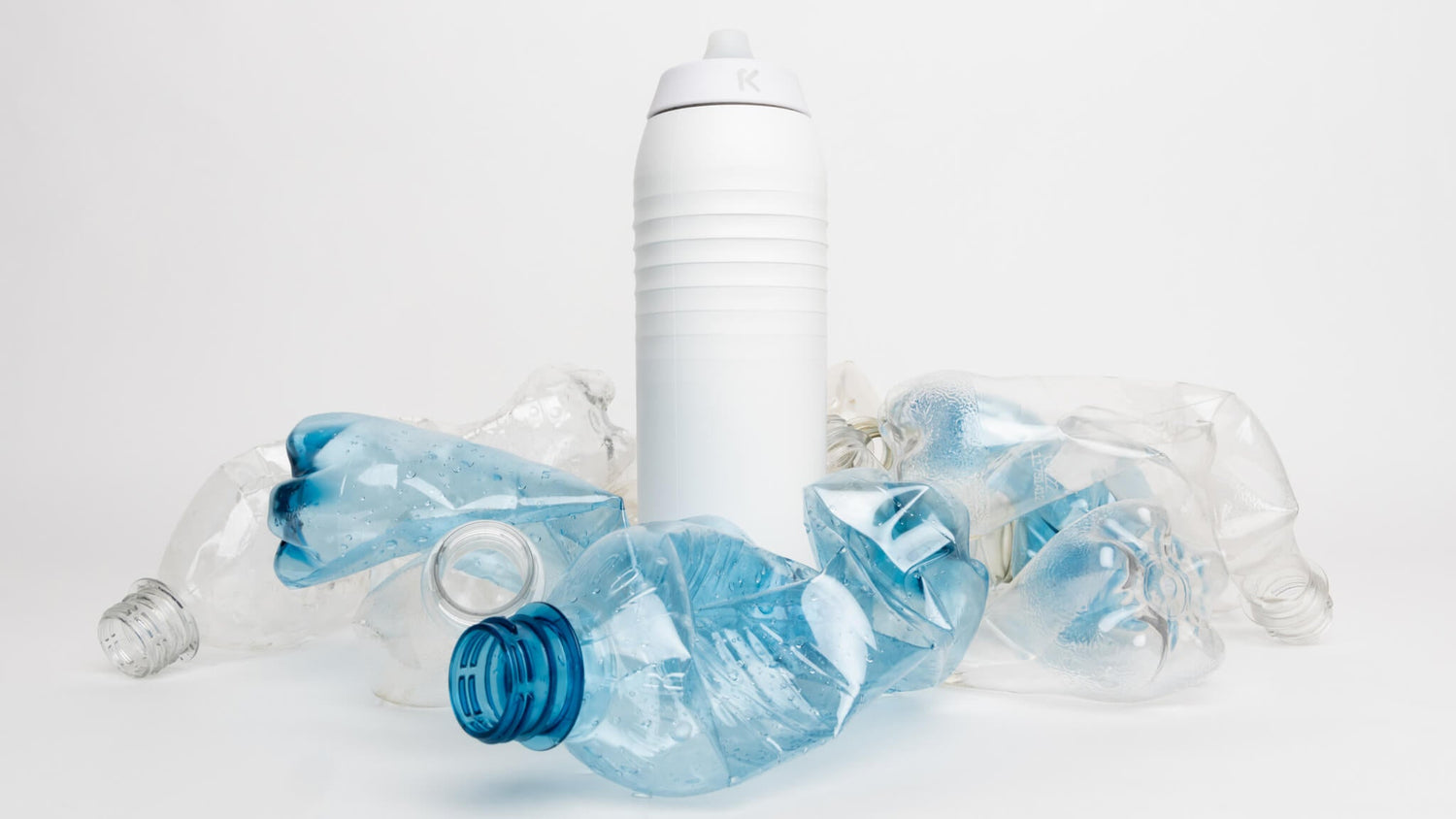Plastic bottles are a practical and supposedly indispensable companion in many sports because they are squeezable, lightweight, and easy to transport.
However, they also carry a variety of health risks. In particular, the absorption of micro- and nanoplastics is a growing problem.
"A recent study by the Medical University of Vienna has shown that we ingest an average of one credit card's worth of microplastics per week"
Bisphenol A (BPA), a substance found in many plastic bottles, is a particular focus of criticism. Although BPA-free alternatives are now available on the market, discussions about the health risks of plastic bottles continue, as the substitute substances such as BPS, BPF, and BPZ are also considered similarly concerning.
Below you will find the 10 biggest health risks and problems associated with drinking from these bottles:
-
Microplastic absorption:
Microplastic particles can remain in our body tissues and organs, causing inflammation and toxicity. They can affect hormone balance and the immune system and increase the risk of certain diseases such as diabetes, obesity and cancer. In addition, due to their small size, microplastic particles can pass through biological barriers such as the blood-brain barrier and potentially affect the nervous system.
-
Hormonal disorders:
Plastic bottles can contain hormone-like chemicals that get into our drinking water and affect our hormones. These chemicals can increase the risk of breast cancer and other hormone-dependent cancers.
-
Bacteria and germs:
Plastic bottles are an ideal breeding ground for bacteria and germs. The bottle cannot be completely cleaned due to the sponge-like structure of the plastic. This allows bacteria and germs to multiply and cause health problems, especially in people with weakened immune systems.
-
Damage to the nervous system:
If a plastic bottle is used for too long, the plastic can get into the water and release chemicals that can be toxic. Some chemicals in plastic bottles can damage the nervous system and cause developmental disorders and cancer. There is also evidence that the risk of neurological diseases such as Alzheimer's and Parkinson's is increased.
-
Changes in reproductive functions:
Chemicals in plastic bottles can affect reproductive functions. BPA and other chemicals can increase the risk of miscarriages, premature births, and birth defects.
-
Poor dental health:
Drinking from a plastic bottle can affect dental health. If we constantly drink from a plastic bottle, our teeth can be attacked and the formation of cavities can be accelerated.
-
Plasticizers
Phthalates are chemicals used in plastics to make them soft. They can get into the water in the plastic bottle and have been linked to a number of health problems, including hormonal disorders, birth defects and cancer.
-
Mold:
Mold growth in plastic bottles can cause health problems, especially in people with weakened immune systems or allergies. Mold can also produce toxins that can get into the water in the bottle and potentially have health effects. In addition, the mold in the bottle can cause unpleasant odors and tastes that can impair the drinking experience. It is therefore important to clean plastic bottles regularly and dispose of them at the first sign of mold.
-
Decomposition from heat
If plastic bottles are filled with liquids that are too hot or heat up due to sunlight, for example in summer, the material of the bottle can melt or decompose. This can release chemicals into the liquid that can be absorbed by the body.
-
Odor and taste problems:
Plastic bottles can change the taste and smell of drinks. If the bottle is not cleaned meticulously and regularly, residue can accumulate on the surface and cause unpleasant odors and tastes.
In summary, drinking from a plastic sports bottle poses significant health risks. The absorption of micro- and nano-plastic particles, as well as potentially harmful chemicals such as BPA and phthalates, can lead to various long-term illnesses, including metabolic disorders, cancer and infertility.
Are there healthy plastic bottles?
In general, all plastics have the potential to release chemicals and thus impair our health.
However, some manufacturers of plastic bottles advertise special materials and technologies that are supposedly safer and healthier than conventional plastic bottles. However, these claims are controversial and not always sufficiently scientifically proven.
It is especially important to ensure that the bottles are free of harmful chemicals such as BPA and plasticizers.
However, there are some concerns about the safety of substitutes for BPA used in BPA-free products. BPS, BPF and BPZ are considered similarly concerning as BPA, as they can also exhibit hormonal activity.
To minimize health risks, it is advisable to use alternatives such as stainless steel, glass, or ceramic bottles.
If you are concerned about your health but don't want to sacrifice flexibility, squeezability, and lightness during sports, a KEEGO is probably your ideal companion.
KEEGO combines the advantages of plastic and metal bottles by combining the light weight and flexibility of a plastic bottle with the durability, safety and resistance of a metal bottle.
The KEEGO is squeezable like a plastic bottle, but has an interior made of durable titanium that protects drinks from microplastics, bad taste and migrating substances.

Although plastic bottles may initially seem inexpensive, the costs can add up over time, especially if they need to be replaced regularly due to wear and tear or loss. Reusable alternatives can be the more cost-effective and environmentally friendly choice in the medium term, as confirmed by a recent survey of more than 1,000 KEEGO users.
Accordingly, the KEEGO is in use 4.7 times longer on average than comparable plastic sports bottles. This also contributes to a smaller ecological footprint.
Overall, it is important to be aware of the impact that the choice of water bottle can have on our health and the environment. When choosing a bottle, we should make sure that it is of high quality, easy to clean and avoids any contact with potential pollutants.
 KEEGO with inner layer made of pure titanium
KEEGO with inner layer made of pure titanium
Sources:
-
Elisabeth S. Gruber, Vanessa Stadlbauer, Verena Pichler, Katharina Resch-Fauster, Andrea Todorovic, Thomas C. Meisel, Sibylle Trawoeger, Oldamur Hollóczki, Suzanne D. Turner, Wolfgang Wadsak, A. Dick Vethaak, Lukas Kenner. "To waste or not to waste – questioning potential health risks of micro-and nanoplastics with a focus on their ingestion and potential carcinogenicity." Exposure & Health, 2022. DOI: 10.1007/s12403-022-00470-8.
-
Schmidt, C.W. (2016). Bisphenol A in the Food Supply: Updated Exposure and Mitigation Strategies. Environmental Health Perspectives, 124(7), A115-A120. doi: 10.1289/ehp.124-A115
-
Wagner, M. & Oehlmann, J. (2009). Endocrine disruptors in bottled mineral water: total estrogenic burden and migration from plastic bottles. Environmental Science and Pollution Research, 16(3), 278-286. doi: 10.1007/s11356-009-0107-7
-
Li, J., Zhou, G., & Zhang, J. (2011). Toxicity of nano-TiO2 on algae and the site of reactive oxygen species production. Aquatic Toxicology, 104(3-4), 242-250. doi: 10.1016/j.aquatox.2011.04.002
-
European Food Safety Authority (EFSA). (2015). Scientific opinion on the risks to public health related to the presence of bisphenol A (BPA) in foodstuffs: executive summary. EFSA Journal, 13(1), 3978. doi: 10.2903/j.efsa.2015.3978
-
United States Environmental Protection Agency (EPA). (2012). An Introduction to Indoor Air Quality (IAQ): Volatile Organic Compounds (VOCs). Retrieved from https://www.epa.gov/indoor-air-quality-iaq/volatile-organic-compounds-impact-indoor-air-quality
-
National Institute of Environmental Health Sciences (NIEHS). (2019). Bisphenol A (BPA). Retrieved from https://www.niehs.nih.gov/health/topics/agents/sya-bpa/index.cfm
-
World Health Organization (WHO). (2011). Guidelines for Drinking-water Quality, Fourth Edition. Geneva: WHO Press. Retrieved from https://www.who.int/water_sanitation_health/publications/2011/dwq_guidelines/en/


